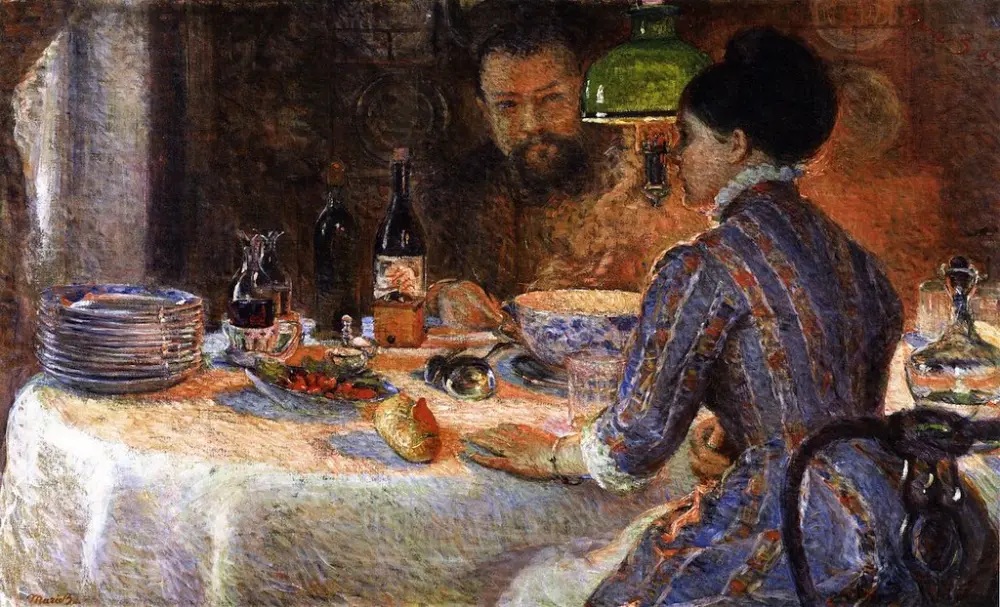
APPRECIATING THE IMPRESSIONIST MARK OF MARIE BRACQUEMOND
Written by S.S. Thompson
Photographs by Wesley Kemp
IT is widely agreed upon that French artist Pierre-Auguste Renoir was a leading painter in the 19th century Impressionist art movement. An art form that encompasses a different way of seeing and acts as a form of immediacy and movement. Capturing the fleeting qualities of light, color, and atmosphere as well as the emerging psychological principles concerning human consciousness, it was a new and controversial practice. It plays with unusual visual angles and inclusions of movement as crucial elements of human perspective. Radical artists of the time, such as Claude Monet, Frederic Bazille, Alfred Sisley, and other Parisian creators violated the rules of academic painting often being the target of scrutiny for it.
These bold artists are masters of their craft, but it’s notable that it was not men alone who “rebelled” against what was acceptable. Due to the socio-economical and political inequalities between the two sexes, women often didn’t have the rights of men. They were particularly excluded from the imagery of the bourgeois social sphere of the boulevard, cafe, and dance hall. They were excluded from the formative discussions that resulted in meeting in those places; where male Impressionists were able to form and share ideas about Impressionism. This did not keep ladies away from the art form. Mary Cassatt, Berthe Morisot and Marie Bracquemond soon painted their influential way in art history becoming the three ladies of Impressionism - “le trois grandes dames."

Bracquemond is unjustly much lesser known compared to Cassatt and Morisot who both had supportive influences from the early days of their painting careers. Her personal story is filled with struggle-against-all-odds from the early childhood. Losing her sea captain father at a fragile age threw her family into rough waters that her re-married mother often navigated with frequent uprooting. Spending much time moving and resettling as a working-class family did not leave Marie freedom to establish roots.
Marie’s first painting attempts started with a birthday present to her mother, having made her own pigments out of crushed flowers. Whilst living in Etampes, Marie insisted on painting lessons and ended up under the tutelage of M. Wasser, an art restorer. She never received the formal training available to women from higher societal classes via family connections or influence. Regardless of not being born into wealth, her path crossed with neoclassical artist Jean Auguste Dominique Ingres who saw her talent and guided her developing style. He encouraged Marie to submit to the Salon as one of his students in 1857. Not only did she follow the suggestion, but her work was accepted on first try at the young age of 16. Her confidence in her youthful emerging talent was born out by the Salon’s acceptance. Soon she was receiving commissions of her own, creating original works, and also commissioned to make copies of masterpieces at the Louvre. It was there she met her future husband Felix in 1867.

Three Graces, 1880

The Artist’s Son and Sister in the Garden at Sevres, 1890
Marie’s talent was already apparent, albeit still fully developing her unique style that later was strongly influenced by Degas, Gauguin and Monet. Marie expressed the severity of Ingres’ work along with his belief that women lacked drive and perseverance made her pull away, leaving the tutorial relationship behind. Marie began leaning toward the influences of Impressionist masters of the time.
Once married, Felix, who was a painter and etcher, introduced his new wife to the art of etching. They often worked together creating etchings for plates, panels, and the Society of Painter-Etchers. The marriage seemed a perfect pairing of artists bonding over their love of creating. According to their only son Pierre, however, it was Felix who ended up holding Marie back as their personalities and artistic styles proved incompatible. Blissful working as a pair did not last long as Marie found etching too limiting, resulting in a return to painting.

Marie Bracquemond, Self-Portrait 1870

Pierre Painting a Bouquet

Garden Seen From the Window
At the turn of the 1880, Bracquemond shifted towards Impressionism. Moving from her studio to en plein air (the outdoors), she initiated the effort to capture the delicate play of light, painting white dresses, and often cropping her work to capture delicate moments. Her forms were less sketchy or spontaneous, and more planned than the works of many fellow artists. Marie was a planner. She worked diligently borrowing from her Neoclassical training and finished surfaces custom to the classical style.

To her husband’s dismay, Marie began exhibiting with the Impressionists in 1879, 1880 and 1886. Since most of her work went to private collectors, lacking any substantial public exhibitions, her legacy in artwork is stunted. Felix did not see eye to eye with Marie’s vision and adversely kept her art from the wider audience by refusing to show it to guests. It was largely kept hidden from public view.
A family friend and art critic, Gustave Geffroy described Felix as authoritarian and argumentative, so often his family bent to his will to keep the peace. Pierre, who was the biggest supporter of his mother’s work describes his father as someone who sought isolation for his family. Despite Marie’s gift, drive, and enthusiasm, her ailing health, oppressive marriage, and familial obligations eventually caused a stoppage to her painting.
It is as of recently that art historians have researched and observed artists with more diverse backgrounds. Art historical narratives have been highly stringent to change. This factor as well as lack of support with the opportunity to exhibit and widely produce work has kept Marie Bracquemond’s legacy unjustly small. Yet, she marks a significant chapter with a shift in art history at large, making her one of The Women of Impressionism. An artist that has rightfully earned the Grande title next to Cassatt and Morisot. -